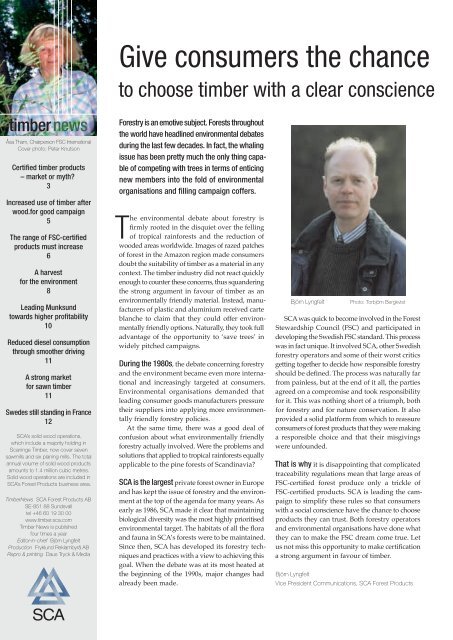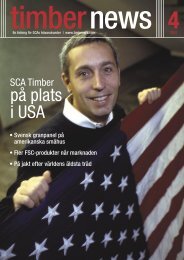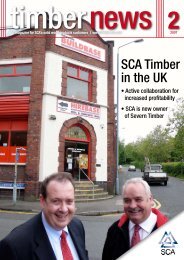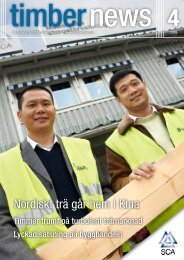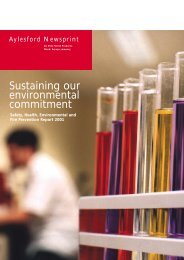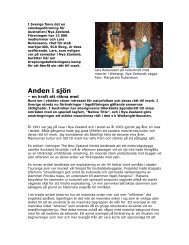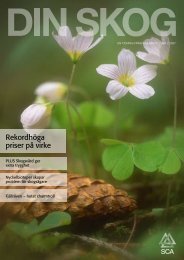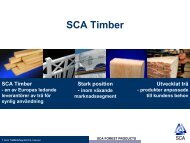TimberNews 4.02-engelsk - SCA Forest Products AB
TimberNews 4.02-engelsk - SCA Forest Products AB
TimberNews 4.02-engelsk - SCA Forest Products AB
Create successful ePaper yourself
Turn your PDF publications into a flip-book with our unique Google optimized e-Paper software.
Give consumers the chanceto choose timber with a clear consciencetimbernewsÅsa Tham, Chairperson FSC InternationalCover photo: Peter KnutsonCertified timber products– market or myth?3Increased use of timber afterwood.for good campaign5The range of FSC-certifiedproducts must increase6A harvestfor the environment8Leading Munksundtowards higher profitability10Reduced diesel consumptionthrough smoother driving11A strong marketfor sawn timber11Swedes still standing in France12<strong>SCA</strong>’s solid wood operations,which include a majority holding inScaninge Timber, now cover sevensawmills and six planing mills. The totalannual volume of solid wood productsamounts to 1.4 million cubic metres.Solid wood operations are included in<strong>SCA</strong>’s <strong>Forest</strong> <strong>Products</strong> business area.<strong>TimberNews</strong> <strong>SCA</strong> <strong>Forest</strong> <strong>Products</strong> <strong>AB</strong>SE-851 88 Sundsvalltel +46 60 19 30 00www.timber.sca.comTimber News is publishedfour times a yearEditor-in-chief Björn LyngfeltProduction Fryklund Reklambyrå <strong>AB</strong>Repro & printing Daus Tryck & Media<strong>Forest</strong>ry is an emotive subject. <strong>Forest</strong>s throughoutthe world have headlined environmental debatesduring the last few decades. In fact, the whalingissue has been pretty much the only thing capableof competing with trees in terms of enticingnew members into the fold of environmentalorganisations and filling campaign coffers.The environmental debate about forestry isfirmly rooted in the disquiet over the fellingof tropical rainforests and the reduction ofwooded areas worldwide. Images of razed patchesof forest in the Amazon region made consumersdoubt the suitability of timber as a material in anycontext. The timber industry did not react quicklyenough to counter these concerns, thus squanderingthe strong argument in favour of timber as anenvironmentally friendly material. Instead, manufacturersof plastic and aluminium received carteblanche to claim that they could offer environmentallyfriendly options. Naturally, they took fulladvantage of the opportunity to ‘save trees’ inwidely pitched campaigns.During the 1980s, the debate concerning forestryand the environment became even more internationaland increasingly targeted at consumers.Environmental organisations demanded thatleading consumer goods manufacturers pressuretheir suppliers into applying more environmentallyfriendly forestry policies.At the same time, there was a good deal ofconfusion about what environmentally friendlyforestry actually involved. Were the problems andsolutions that applied to tropical rainforests equallyapplicable to the pine forests of Scandinavia?<strong>SCA</strong> is the largest private forest owner in Europeand has kept the issue of forestry and the environmentat the top of the agenda for many years. Asearly as 1986, <strong>SCA</strong> made it clear that maintainingbiological diversity was the most highly prioritisedenvironmental target. The habitats of all the floraand fauna in <strong>SCA</strong>’s forests were to be maintained.Since then, <strong>SCA</strong> has developed its forestry techniquesand practices with a view to achieving thisgoal. When the debate was at its most heated atthe beginning of the 1990s, major changes hadalready been made.Björn Lyngfelt<strong>SCA</strong> was quick to become involved in the <strong>Forest</strong>Stewardship Council (FSC) and participated indeveloping the Swedish FSC standard. This processwas in fact unique. It involved <strong>SCA</strong>, other Swedishforestry operators and some of their worst criticsgetting together to decide how responsible forestryshould be defined. The process was naturally farfrom painless, but at the end of it all, the partiesagreed on a compromise and took responsibilityfor it. This was nothing short of a triumph, bothfor forestry and for nature conservation. It alsoprovided a solid platform from which to reassureconsumers of forest products that they were makinga responsible choice and that their misgivingswere unfounded.That is why it is disappointing that complicatedtraceability regulations mean that large areas ofFSC-certified forest produce only a trickle ofFSC-certified products. <strong>SCA</strong> is leading the campaignto simplify these rules so that consumerswith a social conscience have the chance to chooseproducts they can trust. Both forestry operatorsand environmental organisations have done whatthey can to make the FSC dream come true. Letus not miss this opportunity to make certificationa strong argument in favour of timber.Björn LyngfeltPhoto: Torbjörn BergkvistVice President Communications, <strong>SCA</strong> <strong>Forest</strong> <strong>Products</strong>


